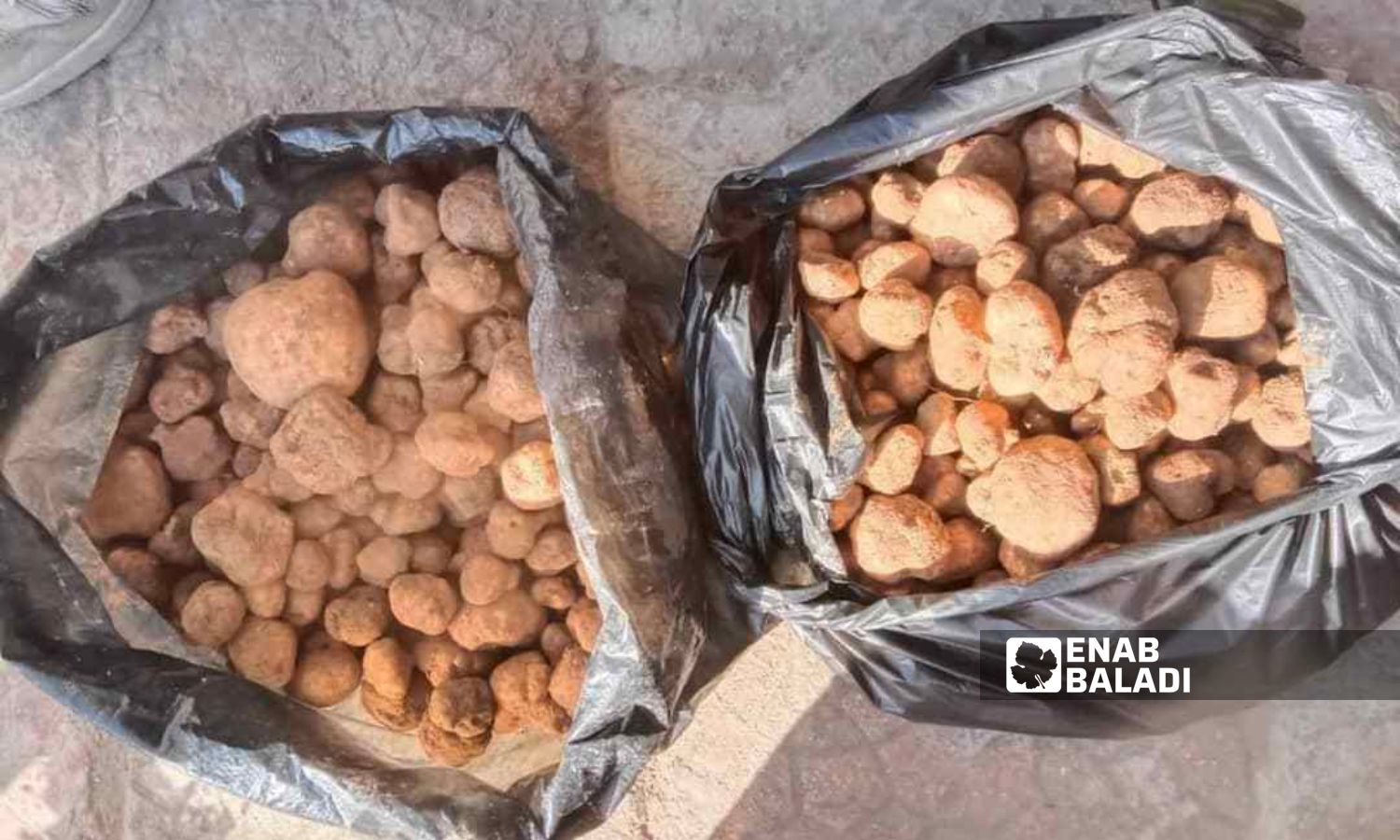



Al-Hasakah – Rita Ahmad
The markets of al-Hasakah city began filling with truffles as the harvesting season kicked off earlier in February, despite the high prices ranging from 250,000 to 400,000 Syrian pounds per kilogram, while the price of a kilogram of truffles in the previous season did not exceed 75,000 pounds.
Jamal al-Mohammed, one of the truffle sellers in the al-Hasakah market, told Enab Baladi that this year’s truffle season began early due to the warm weather and the humidity and rains experienced in the Syrian Jazira badia, especially in the southern region and on the slopes of Mount Abdul Aziz.
The seller explained that the early growth does not reflect the real market, as demand is still high and quantities are limited, which has driven up prices compared to the previous season.
The seller expected truffle prices to drop in the coming days, marking the beginning of the real marketing season, with more quantities available and various types.
Al-Mohammed spoke about the types, which are “al-Zubaidi,” considered the most expensive with a whitish color, “al-Jaibi,” which is black and cheaper than “al-Zubaidi,” and “al-Harq,” which is black with a white core.
In any case, prices remain high in general due to low income levels among most residents. Most people in al-Hasakah rely on agriculture as a source of income, with labor wages in agriculture or other professions ranging between 25,000 and 40,000 Syrian pounds per day, while the minimum salary for employees in the region, which is under the Autonomous Administration of North and East Syria (AANES), is one million and 40,000 pounds (the US dollar equals 14,650 pounds).
Enab Baladi monitored truffle prices in al-Hasakah city markets, which ranged between 250,000 and 400,000 Syrian pounds per kilogram, varying according to the type and size of the truffle, while a kilogram of wild mushrooms is sold for about 100,000 pounds.
The truffle mushroom grows in protected lands that are not exposed to plowing, seeding, fertilizing, and other agricultural operations, which explains its presence in natural reserves, the deserts of Raqqa, al-Hasakah, and Deir Ezzor. Frequent lightning accompanying the rains is an indicator of “truffle abundance.”
Jamal Mahmoud (66 years old) from the city of Qamishli told Enab Baladi that truffles are described as “the daughter of lightning and thunder,” and that the season is bountiful when it rains a lot at the beginning of fall, noting that this period is the best for truffle growth.
For his part, Samir Sattou (49 years old), who lives in the Mount Abdul Aziz area in rural al-Hasakah, said that most residents benefit from the annual truffle harvesting season, with entire families participating.
Sattou told Enab Baladi that the search for truffles takes between 8 and 12 hours a day, and that the appearance of truffles is usually indicated by the presence of the poppy plant nearby. Finding one truffle is the start of the search in the surrounding area, which is conducted in a circular pattern.
Families rely heavily on the truffle season as a source of income, and according to Sattou, experience plays a significant role in finding them. He noted that harvesting is not easy and requires physical effort and transportation costs across vast areas.
The truffle harvesting period is relatively short, but has a high financial return; workers sell what they gather to merchants or in markets. Collectors of truffles are also referred to as “al-Jammaaya,” according to Sattou.
Gathering truffles is no longer an “enjoyable” trip as it used to be, after many individuals lost their lives in the search for them due to various reasons, such as attacks by unknown assailants or the explosion of landmines and war remnants.
Truffle collector Samir Sattou mentioned to Enab Baladi that collecting truffles has become dangerous after years of conflict in Syria, noting that the desert of al-Hasakah is less dangerous than other Syrian desert areas (Raqqa, Deir Ezzor, and Homs).
On February 25, 14 truffle gatherers were killed in the Raqqa desert when a landmine exploded in a vehicle carrying them, along with eight injured who were transported for treatment, in an incident that was the third of its kind within 24 hours.
if you think the article contain wrong information or you have additional details Send Correction